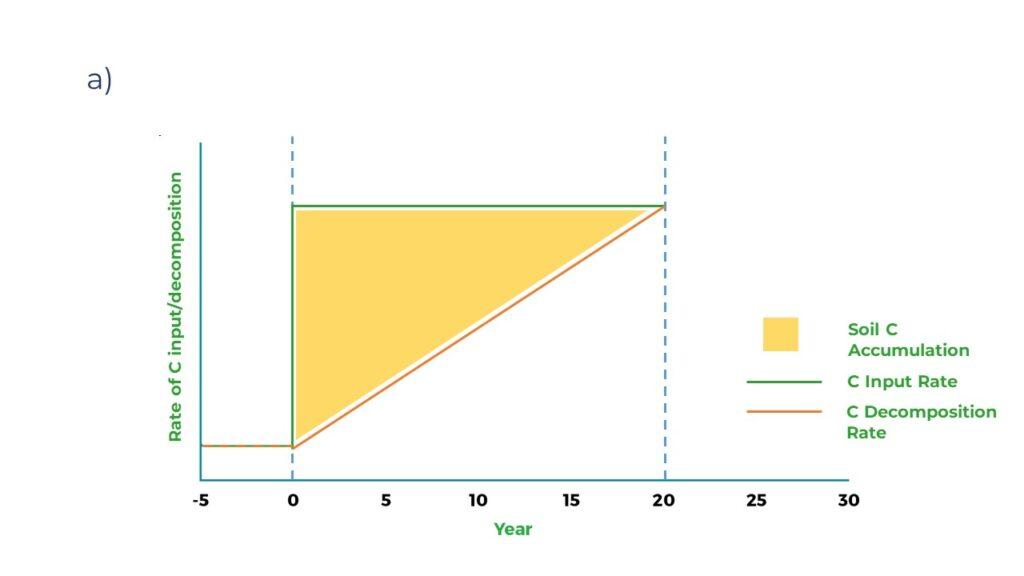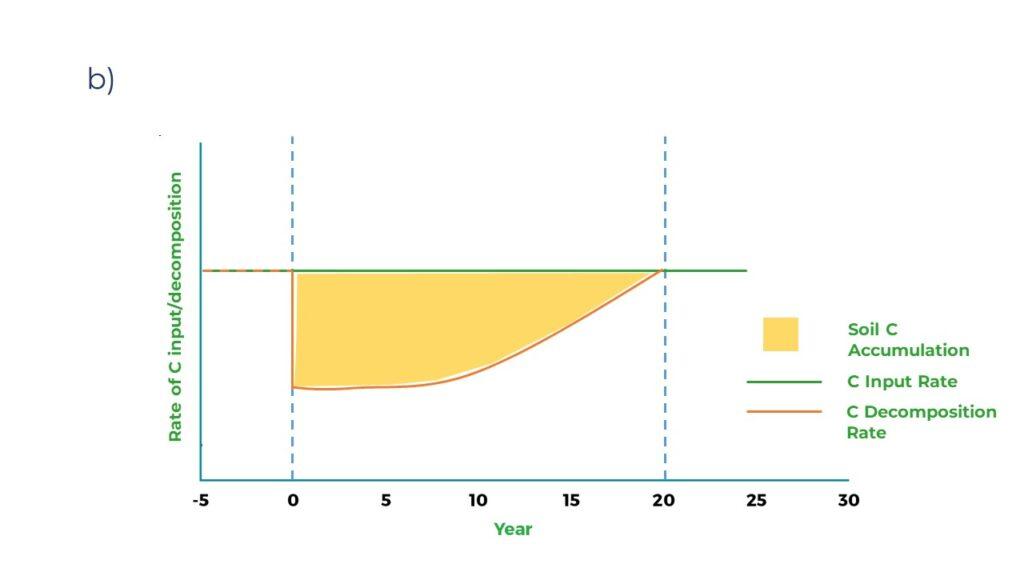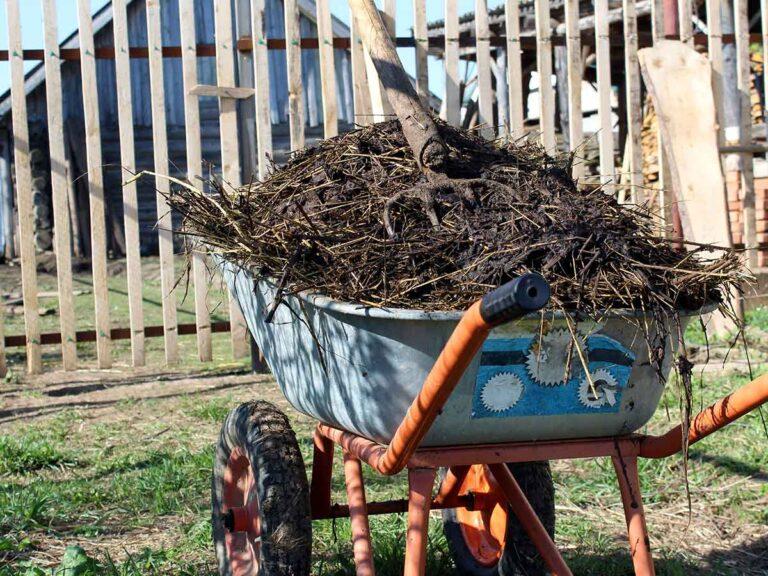Table of Contents
Introduction to soil carbon
Soils contain a huge amount of carbon; by some estimates almost double the amount in the atmosphere.
That carbon underpins the health of the land by improving soil structure, reducing soil compaction, making nutrients more available to plants and helping the soil store more water to protect against drought.
Storing more carbon in the soil (aka soil sequestration) has also received a lot of attention as an approach to offset greenhouse gas emissions in the fight against climate change. Whether it’s for improved soil health or soil sequestration, increasing the carbon content of your soil can be a real asset for a farm. Understanding soil carbon and how your practices influence it is key to getting the most out of your soils. Agrecalc is here to support you on this journey.
What is soil carbon?
Usually when we say “soil carbon” we are talking about the carbon in soil organic matter (SOM). SOM is made up of plant material that has been incorporated into the soil and been at least partially decomposed. This material can come directly from plants or can take a detour through the guts of livestock.
Soil organic matter is a dynamic system: it is constantly decomposing even as new material is added to the soil. Over time, the rate at which SOM decomposes and the rate that new material enters the soil equalise. This is called a dynamic equilibrium.
When the soil is at equilibrium, there is little change year-on-year in the organic matter content of the soil.

Even though at equilibrium the rates of inputs and decomposition will be equal, the actual amount of carbon in the soil varies depending on what these rates are. Graph A (above) shows how increasing the amount of carbon entering the soil can increase your soil carbon, and graph B (below) shows how reducing the rate of decomposition can achieve the same thing. In both cases, soil carbon will increase over roughly 20 years, after which a new equilibrium is reached.

Different ways of managing the soil can change the rate of carbon input and carbon breakdown. These rates are also affected by factors like your soil type and the local climate. Maximising soil carbon relies on finding a combination of farming approaches that boost soil carbon inputs and reduce decomposition for your specific farm.
The following sections explain some of the ways you can achieve this in arable and grassland fields. It’s important to remember that increases in soil carbon only last as long as you keep managing the soil in the same way.
This means that when considering changes in management, you should think about whether the changes are financially sustainable for your business. Changing how you manage your soils for a few years and then going back to the old way of doing things will undo all your hard work. The changes you make have to be permanent to be effective, so you should focus on making changes that are inexpensive or that could produce co-benefits for your business down the line.
Improving soil carbon in arable fields
Arable farming takes a lot of plant material off the land. This usually means that the inputs of carbon to the soil in the form of dead plant material are low. If you want to improve soil carbon, you should focus on techniques that boost carbon inputs to the soil (i.e. graph A above).
Spreading manure, digestate or compost
Partially decomposed organic material is one of the best soil inputs for increasing soil organic matter. During decomposition the compounds that are most easily broken down are removed, turning into carbon dioxide or methane. What gets left behind is much more resistant to decomposition, and so when it is incorporated into the soil it tends to stick around for longer.
Farmyard manure contains plant material that has been decomposed in animal guts, and as such is great for boosting soil carbon. The impact that manures have on soil carbon will depend on the quality of that manure. Generally, cattle manure has the biggest impact as it contains a lot of carbon relative to its nitrogen content and is rich in decomposition-resistant carbon.
Bacteria need nitrogen in order to keep decomposing organic matter, so a high C:N ratio makes manures more resistant to further decomposition. Pig and poultry manures tend to have less of an impact on soil carbon both due to their C:N ratios and the fact that the carbon in these manures is more easily decomposed. This is because the foods pigs and chickens eat is more easily decomposed than the grass that cattle eat.
Digestate (one of the products of anaerobic digesters) and compost are also good sources of organic matter. They are usually less nitrogen-rich than manure. That means if you are in a Nitrate Vulnerable Zone you can apply more of these amendments than you could manure.
It also means they are fairly resistant to decomposition, making them more effective at boosting soil carbon.

When applying manures, compost or digestate you should consider whether you are looking to replace your bag fertiliser or just to improve the condition of your soil. This is because there is a trade-off between the nitrogen content of organic material and its effectiveness for boosting soil carbon. In the long run, you want to be buying the most cost-effective material for your goals as this will be financially sustainable. Keep this in mind if you are thinking of incorporating any of these materials into your rotation.
Green manures and cover crops
A green manure is a crop that is grown to improve soil characteristics. After the crop has grown, it can either be ploughed back into the soil or sprayed with herbicide. Green manures can provide nutrition for the following crop, especially if the manure crop is nitrogen-fixing. Cover crops grown over winter to minimise fallow ground can also be used as green manures.
Green manures are not a substitute for applying animal manure, and the soil carbon benefit of green manures is less than the benefit of animal manures. This is because unlike in animal manures, green manures contain a mixture of carbon types, some of which are very easily broken down. Having an additional crop in the year can also increase emissions of nitrous oxide from crop residues. That said, some green manures can fix nitrogen, reducing the amount of bag fertiliser you need to use. As with animal manures, there is likely to be a trade-off between how much nitrogen a green manure can supply to the following crop and how effective it is at improving soil carbon.
Overall, the net impact of a green manure on your greenhouse gas emissions will depend on what crop is used and how it impacts the productivity of your main crop. This means there is not a one-size-fits-all approach to using green manures for carbon sequestration. Consider testing a green manure on one field to start with and use Agrecalc to explore how this affects your greenhouse gas profile at the whole-farm level.
Reduced / no-till
Reduced and no-till methods are often touted as a key method to improve soil health. These approaches have performed well in drier farming regions, but there is less evidence in the UK that reduced tillage improves soil carbon.
In a UK context, reduced tillage generally means cultivations are much shallower, whereas on no-till farms specialist seed drills are used to sow seed into the previous season’s residues. The goal of these approaches is to reduce the breakdown of nutrients by minimising soil disturbance. In theory, reducing soil disturbance should also protect soil organic matter, reducing the decomposition of soil carbon.
Tillage plays an important role in reducing soil compaction and controlling weeds and diseases. Due to our moist climate, the UK is prone to all of these problems.
If weeds and diseases reduce yields then the amount of carbon entering the soil from crop residues will also be reduced. This can counteract the benefit of reduced decomposition of soil carbon.
With all this in mind, reduced and no-till farming won’t be the right fit for every business. Talk with your agricultural consultant if you want to explore no-till further, so you can get a better understanding of the impact it could have for you.
Including a grassland ley in the rotation
Arable fields have lower soil carbon than grassland. This is due to a combination of greater soil disturbance from cultivation and reduced inputs of plant matter to the soil. Including grass into an arable rotation gives the soil some time to recharge between cultivations. When under grass the field isn’t being ploughed, which reduces the rate of carbon decomposition. Grasses also allocate more growth to their roots than most arable crops, leading to greater carbon inputs to the soil under grass.
Unlike in permanent pastures, grass leys will eventually be ploughed up to make way for following crops. Cultivation leads to the decomposition of some of the soil carbon built up under the ley. This means that the average soil carbon in the long term will be lower in an arable-ley rotation than under a permanent grassland. Increasing the length of the ley in the rotation will lead to higher soil carbon as ploughing occurs less often and the high carbon inputs under grass occur over more of the rotation.
As with all changes to management, the benefits of a grass ley should be considered against the impacts it has on other parts of the farm. Reducing the fraction of the rotation under cash crops may not be financially viable, and if the ley is used to support livestock then the emissions from these animals may outweigh soil carbon gains. Talk with your agricultural consultant to find the right length of ley for your business, and use Agrecalc to assess whether increases in soil carbon outweigh the wider emission impacts of the ley on your farms.

Improving soil carbon in grassland fields
Grasslands tend to have higher soil carbon than arable systems due to reduced soil disturbance and increased carbon inputs from grass roots. Most grassland management should focus on avoiding the loss of soil carbon given grasslands already have high soil carbon.
The evidence on ways to improve grassland soil carbon is very mixed. A common theme is that the impact of any management approach is very context specific. As a result, the suggestions made below are less prescriptive and more an indication of areas that are known to affect grassland soil carbon. For the best chances of boosting soil carbon, you will need to work alongside your agricultural consultant to find the right practices for your farm.
Optimising stocking density
Maximising the output of grasslands has always been a matter of getting your stocking density right, and unsurprisingly this is also true for soil carbon. Having too many animals on the land leads to soil compaction, a decline in forage quality and, in the worst-case, grass death. These impacts lead to reduced soil carbon. This is because less grass growth occurs, meaning the carbon inputs to the soil are reduced.
In some systems, grazing can stimulate grasses to put on root growth. Roots contribute more to soil carbon than above ground material as they are already incorporated into the soil and are less exposed to conditions that promote carbon decomposition. However, the exact amount grazing that is needed to promote root growth remains elusive. Different studies often report conflicting findings.
Some indicate grazing can increase soil carbon when managed properly while others suggest that, for a UK climate, any level of grazing reduces soil carbon versus ungrazed grassland.
Extracting useful advice from such conflicting studies is challenging. An obvious aim should be to avoid overgrazing. Patches of bare land are a crisis indicator across all systems. For more specific indicators and an assessment of whether you’re overgrazing, talk with your agricultural consultant.
Renovating permanent pasture with productive grasses
Modern perennial ryegrass varieties are substantially higher yielding than grasses found in unimproved permanent pasture. This has benefits not only for forage yield, but also for soil carbon. Increased productivity means more carbon is drawn down by grasses, which means more carbon is pumped into the soils. UK-based experiments have demonstrated that sward renovation in permanent pastures can increase soil carbon.
However, other studies have indicated that soil carbon isn’t very responsive to differences in how often a pasture is reseeded.
The exact impact of renovation on soil carbon is likely to depend heavily on the quality of the permanent pasture on the land to begin with. If your pasture is relatively unproductive currently then it is likely that sward renovation will improve your soil carbon.
Nutrient management
Applying fertiliser has become an important part of management for some pastures. This is especially true where ryegrass has been planted. Fertilisers can help maximise grass production for livestock. Increased grass yields can increase the carbon inputs to soil, and so when done properly grassland fertilisation can boost soil carbon. However, there is evidence that excess nitrogen can accelerate the breakdown of soil carbon by stimulating bacterial growth.
Fertilisers can also lead to the release of nitrous oxide, which is a potent greenhouse gas. Analysis suggests that this nitrous oxide emission outweighs any increase in soil carbon inputs from fertilisation in the overall GHG balance of grasslands.
To minimise the risk of excess nitrogen causing soil carbon breakdown, it’s important to time your applications of fertiliser correctly. Timing your applications with when grass most needs nitrogen leads to less waste, saving your money and your soil health. The Agriculture and Horticulture Development Board’s RB209 provides provides guidance on how to assess your grassland’s nitrogen needs and time your applications correctly for your field.
Take-home message
We’ve shared a lot of ways you can boost your soil carbon here. It’s a lot of information, so we’d like to summarise some of the key points and common themes.
- Increasing your soil carbon means you either have to increase the amount of carbon going into the soil or reduce the rate at which carbon in the soil decomposes.
- On arable farms, you want to focus on putting high quality carbon back into the soil to replace that lost to repeated tillage. This can be achieved using manures or by growing grass for some of your rotation.
- In grasslands, grass does most of the work getting high quality carbon into the soil. That means your focus should be on safeguarding that grass by avoiding overgrazing, or even boosting its growth by planting more productive cultivars and applying fertiliser in soil-smart ways.
- Whatever your farm produces, financial sustainability is key to sustainable improvements to soil carbon. Always consider your business goals before making changes in practice.
- Only finite improvements to soil carbon are possible, and to maintain those improvements you will have to keep up changes in management far into the future. That means making changes just to sell soil carbon credits isn’t likely to be sustainable.
- Focus on making changes that will benefit your business in other ways. For arable systems this could be through improved crop yields or reduced fertiliser costs. For livestock it could be through reduced feed costs when you have a well-managed grassland underpinning your system.
Healthy soil is the bedrock of farming. Managing your soil well can be a win for you and the planet. We hope that some of the insights we’ve shared here can help you on your soil journey.

